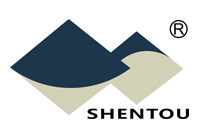CHINA AUTOMOTIVE SUPPLIER QUALITY MANAGEMENT BRIEFING
05/06/2018
Vol. 2, No. 5, May 2018

① QUALITY CHALLENGES & SOLUTIONS WITH YOUR SUPPLIERS IN CHINA
Potential quality risks with production of casting products (II)
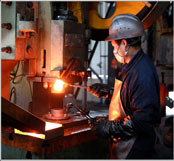
One of the key processes in melting for casting products is the control of their chemical composition, i.e. to ensure that the 5 elements, namely carbon (C), sulfur (S), silicon (Si), manganese (Mn),and phosphorus (P), are within the required material specifications.
But how they should be controlled, what tests should be used, with what methods and standards, these should be determined before the start or production in order to meet the customer requirements.
First, it is important to confirm with customers beforehand on what standards to follow, such as Chinese, European or American, as well as the acceptance criteria and testing methods.
In the melting process, different factories have different methods to control the main carbon content along with the other chemical elements. Typically the carbon silicon testers at the furnace, the spectrometer and/or the carbon sulfur tester are used, but the readings from these three methods are all slightly different.
When customers have no specific requirement on how the carbon content is tested, the use of carbon sulfur tester for testing the carbon content, based on standards of China’s foundry industry, is generally accepted and their readings are usually considered the most authoritative.
Customers sometimes complain that the products they’ve received show a lower carbon content which do not meet the technical requirement. But the foundries would then produce test reports for carbon content from the carbon silicon tester at the furnace to show that the results meet the requirement. The discrepancies are usually results of different testing methods by the two parties, with customers using spectrometers to obtain the carbon content level.
So what type of tests are the most reliable? Other than confirming the acceptance standards and testing methods with customers first, the experienced foundries would use carbon silicon tester at furnace for quick analysis to adjust the carbon content of the molten metal and use the carbon readings from the carbon sulfur testers as the basis for conformity, while relying on the spectrometer readout for the other elements. Moreover, they would periodically calibrate the carbon sulfur testers and the carbon silicon testers at furnace, and compare the carbon readings from the carbon sulfur testers with that of the carbon silicon testers at furnace to ensure consistence between the test results from the two methods.
By Felix SS YUAN
② CRITICAL FAILURE MODES / QUALITY CONTROL POINTS IN FOCUS
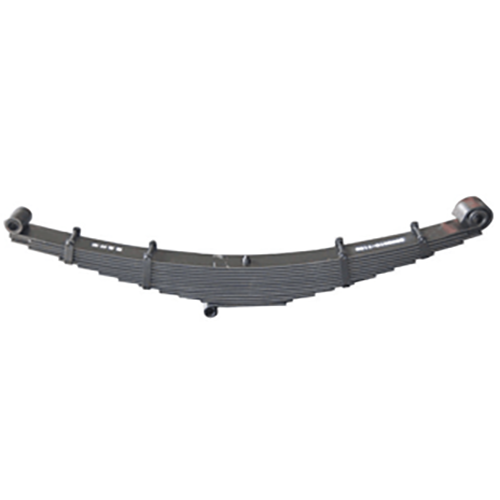
Leaf Spring:
Primary failure Modes:
1. Defective material, i.e. raw materials failed.
2. Metallurgical structure defects caused by improper heat treatment process.
3. Premature failure caused by uneven ball blast or no ball blasting process.
4. Leaf geometric dimension tolerances too large or improperly assembled.
5. Surface quality and appearance:
a)There should be no cracks, flashes, scratches, rust, or other defects harmful to the use of the spring reed surface;
b)The leaf spring assembly should be painted, but no paint on the inner surface of the leaf spring eye bushing (except for rubber bushings). Other rust prevention measures should be taken instead;
c)Fatigue cracking at the surface etching pits. The surface protection layer of the leaf spring is peeled off in use leading to the fatigue crack under high stress.
6. Lower hardness of the leaf spring may lead to reduction of the leaf spring life.
Key preventive measures:
●Pre-delivery inspection items: a) Permanent deformation; b) Static load arch height; c) Stiffness; d) Bushing eye O.D.; e) Verticality of the shackle; f) Parallelism of the shackle; g) Width of the assembly; h) Surface quality, i) Width of the shackle; j) Reed hardness.
●Type testing items: including all Pre-delivery inspection items plus fatigue life tests and metallographic testing.
By Y. WANG
③ KEY CONCEPTS & PRACTICES IN SUPPLIER QUALITY MANAGEMENT
Automotive Aftermarket QMS Standard ( Ⅵ )
The proposed Automotive Aftermarket QMS Standards include Automotive Aftermarket QMS Standard and the Automotive Aftermarket Quality Assurance Capability Assessment Standard.
Here is the proposed model for the aftermarket QMS standard:
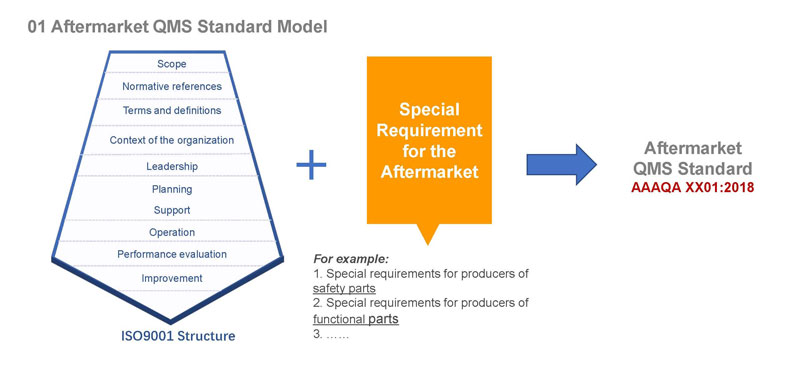
And here is the proposed model for the aftermarket quality assurance capability assessment:
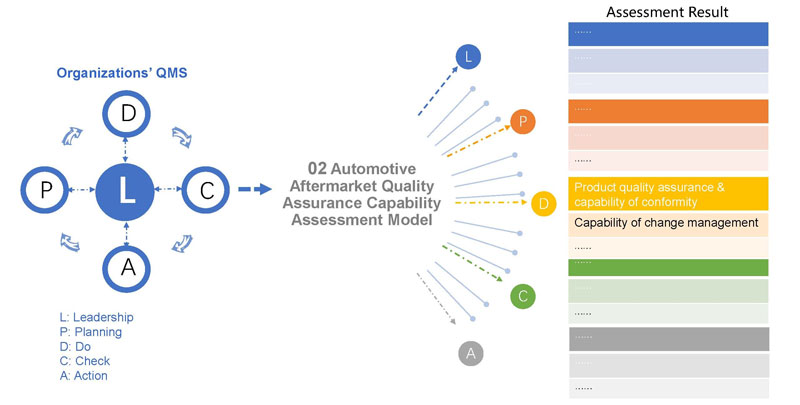
For more detailed information on the aftermarket QMS standard and the general project, please visit www.AAAQA.org.
④ CHINA INDUSTRY & MARKET UPDATE
Cost of raw materials:
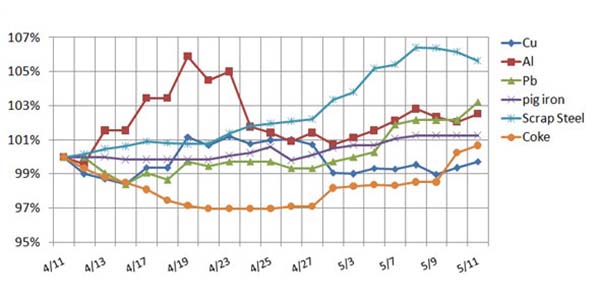
Exchange rates:
![]() USD/RMB: 1:6.35
USD/RMB: 1:6.35
![]() EUR/RMB: 1:7.63
EUR/RMB: 1:7.63
![]() RUB/RMB: 1:0.10
RUB/RMB: 1:0.10
May 2018
The above information is for reference only
⑤ IT HELPS TO KNOW...
Impact of busy farming seasons on production delays There are quite a few large manufacturing companies in the Chinese automobile industry that have high applications of automation and machinery. But with many small-and-medium-sized manufacturers, much of the hard work still depend on manual labor by workers, many of whom are migrant workers from the rural areas.
There are quite a few large manufacturing companies in the Chinese automobile industry that have high applications of automation and machinery. But with many small-and-medium-sized manufacturers, much of the hard work still depend on manual labor by workers, many of whom are migrant workers from the rural areas.
China is still a major agricultural country, with agricultural cultivation dominating the daily work in the countryside. Each year in the vast wheat production regions in northern China, for example, the first busy farming season is for summer harvesting and planting between May and June, i.e. between the 8th solar term (the Lesser Fullness of Grain in the Lunar Calendar) and the 9th solar term (the Grain in Beard), and the second busy farming season is for autumn harvesting and planting in September, i.e. between the 15th solar term (the White Dew) and the 16th solar term (the Autumn Equinox).
For the automobile spare parts manufacturers in northern China where large numbers of migrant workers are from the rural areas, most of them will then have to go back to their farmland to help with the demanding activities on the farm during the two busy seasons, which usually go on for about 10 to 15 days each.
Therefore a unique phenomenon with many small and medium manufacturers in China that happens twice a year is the lack of sufficient workers during the two busy farming seasons, which then result in seriously insufficient productions and long delays in delivery. Because of the variation in the actual start and finish of the busy farming seasons, the full impact could last for about a month each time.
Of course with rapid urbanization of the rural areas in China, many farmers and their families have completely left the countryside and the farms, and more and more young farmers who start to work in factories would not want to return to farm work at all. So manufactures have differently experience during the busy farming seasons depending on their main sources of workers as well as the workers’ age structures.
For international buyers in China, if most of the workers hired by your main suppliers are farmers, you need to make good plans long before to prepare for the serious impact of the annual busy farming seasons.
SHENTOU SUPPLY CHAIN MANAGEMENT CO. LTD. is a Shenzhen, China, based company serving international automotive clients in the implementation of their China strategies and programs. CHINA AUTOMOTIVE SUPPLIER QUALITY MANAGEMENT BRIEFING is a bi-monthly newsletter published by Shentou to address the specific and unique quality challenges and concerns international automotive companies face with suppliers in China. Comments are welcome at qms@shentou.com. Click here to subscribe.
